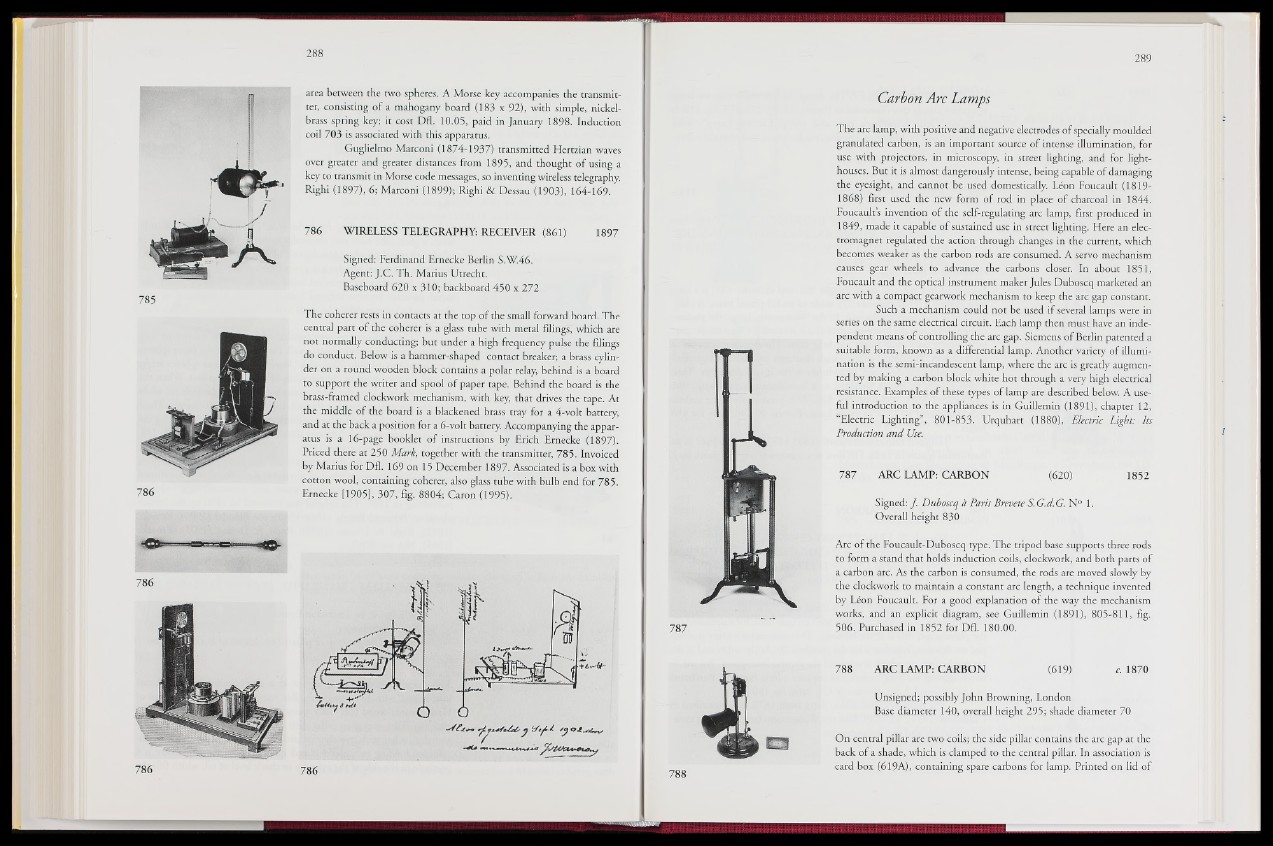
785
area between the two spheres. A Morse key accompanies the transmitter,
consisting of a mahogany board (183 x 92), with simple, nickel-
brass spring key; it cost Dfl. 10.05, paid in January 1898. Induction
coil 703 is associated with this apparatus.
Guglielmo Marconi (1874-1937) transmitted Hertzian waves
over greater and greater distances from 1895, and thought of using a
key to transmit in Morse code messages, so inventing wireless telegraphy.
Righi (1897), 6; Marconi (1899); Righi & Dessau (1903), 164-169.
786 WIRELESS TELEGRAPHY: RECEIVER (861) 1897
Signed: Ferdinand Ernecke Berlin S.W.46.
Agent: J.C. Th. Marius Utrecht.
Baseboard 620 x 310; backboard 450 x 272
The coherer rests in contacts at the top of the small forward board. The
central part of the" coherer is a glass tube with metal filings)" which are
not normally conducting; but under a high frequency pulse the filings
do conduct. Below is a hammer-shaped contact breaker; a brass cylinder
on a round wooden block contains a polar relay, behind is a board
to support the writer and spool of paper tape. Behind the board is the
brass-framed clockwork mechanism, with key, that drives the tape. At
the middle of the board is a blackened brass tray for a 4-volt battery,
and at the back a position for a 6-volt battery. Accompanying the apparatus
is a 16-page booklet of instructions by Erich Ernecke (1897).
Priced there at 250 Mark, together with the transmitter, 785. Invoiced
by Marius for Dfl. 169 on 15 December 1897. Associated is a box with
cotton wool, containing coherer, also glass tube with bulb end for 785.
786 Ernecke 119051, 307, fig. 8804; Caron (1995).
SCO-
786
g n i*
o
^ a / a o r .
■Ma
Carbon Arc Lamps
The arc lamp, with positive and negative electrodes of specially moulded
granulated carbon, is an important source of intense illumination, for
use with projectors, in microscopy in street lighting, and for lighthouses.
But it is almost dangerously intense, being capable of damaging
the eyesight, and cannot be used domestically. Léon Foucault (1819-
1868) first used the new form of rod in place of charcoal in 1844.
Foucaults invention of the self-regulating arc lamp, first produced in
1849, made it capable of sustained use in street lighting. Here an electromagnet
regulated the action through changes in 'the current, which
becomes weaker as the carbon rods are consumed. A servo mechanism
causes gear wheels to advance the carbons closer. In about 1851,
Foucault and the optical instrument maker Jules Duboscq marketed an
arc with a compact gearwork mechanism to keep the arc gap constant.
Such a mechanism could not be used if several lamps were in
series on the same electricaLcircuit. Each lamp then must have an independent
means of controlling the arc gap. Siemens of Berlin patented a
suitable form, known as a differential lamp. Another variety of illumination
Is the semi-incandescent lamp, where the arc is greatly augmen-
llgHjy making a carbon block white hot through a very high electrical
resistance. Examples of these types of lamp are described below. A useful
introduction to the appliances is in Guillemin (1 8 9 3 chapter 12,
-^Electric Lighting”, 801-853. Urquhart ¿jl880), Electric Light: Its
Production and Use.
M87 ARC LAMP: CARBON (620) 1852
787
Signed: J. Duboscq a Paris Brevete S. G.d. G. N° 1.
Overall height 830
Arc of the Foucault-Duboscq type. The tripod base supports three rods
to form a stand that holds induction coils, clockwork, and both parts of
a. Carbon arc. As the carbon is consumed, the rods are moved slowly by
the clockwork to maintain a constant arc length, a technique invented
by Leon Foucault. For a good explanation of the way the mechanism
works, and an explicit diagram, see Guillemin (1891), 805-811, fig.
506. Purchased in 1852 for Dfl. 180.00.
7788 ARC LAMP: CARBON (619) 1870
Unsigned; possibly John Browning, London
Base diameter 140, overall height 295; shade diameter 70
On central pillar are two coils; the side pillar contains the arc gap at the
back of a shade, which is clamped to the central pillar. In association is
card box (619A), containing spare carbons for lamp. Printed on lid of